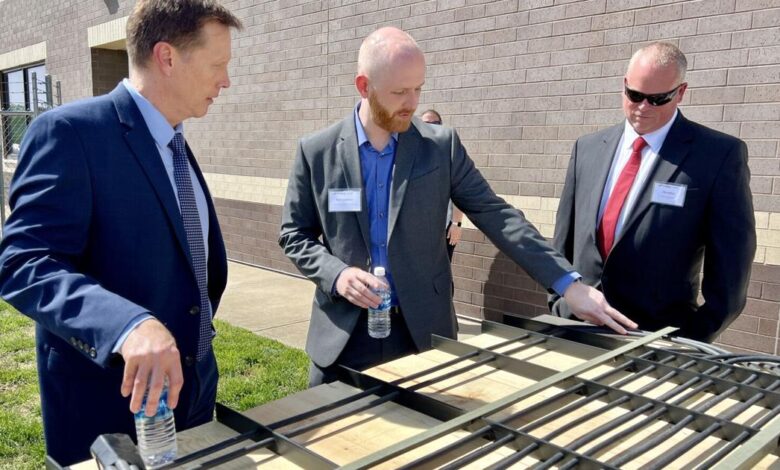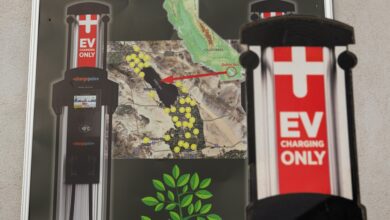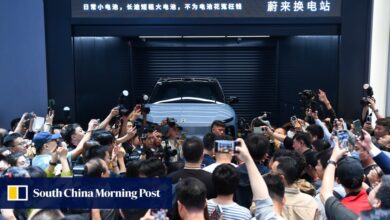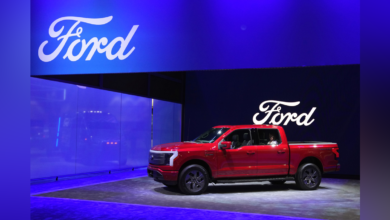Electric avenues: Purdue engineers designing country’s first road to charge EVs on the move | Local News

WEST LAFAYETTE — In 2019, a group of Purdue faculty members and students met with university president Mung Chiang in his office to share their ideas for developing technology that would enable electric vehicles to charge while in motion.
“I thought they were writing science fiction,” Chiang said.
Researchers, government officials and business leaders gathered recently at the Indiana Department of Transportation’s subdistrict office to mark a milestone in the group’s work to turn sci-fi into reality.
A quarter-mile stretch of U.S. 231 which passes in front of the INDOT facility will by next year be ready to host experiments to test a patent-pending system providing power to a heavy-duty electric truck traveling at highway speeds.
Jason Bennett with Cummins Inc., prepares to step into the cab of an electric truck that will test a road bed featuring dynamic wireless power transfer technology developed by researchers at Purdue University.
“We’re excited about the opportunity in front of us,” said INDOT Commissioner Mike Smith. “This is a moment of such transformation potential in our industry. At one point, we said it was impossible to send people to the moon, and Purdue just keeps doing it, right?”
The research leading to the project, among the first of its kind, is built on the development of dynamic wireless power transfer technology. The pavement will use specially designed wireless charging coils embedded beneath the surface to send power to an electric vehicle with magnetic fields.
The concept, officials said, is similar to pads which generate magnetic fields to charge cellphones, but on a much larger scale.
“Your iPhone is charging, what, five volts?” said John Haddock, a professor of civil engineering at Purdue. “This system will run about 230 kilowatts, so that’s the kind of difference in the power you’re talking about. Scaling it up is not that simple, though. That’s why we have the electrical engineers.”
AN ALTERNATIVE CHARGING SOLUTION
The uneven rollout of a federal program designed to entice states to build up to half a million electric vehicle charging stations by 2030 has not done much to deter demand for EVs, which represented 7.6% of the overall national market last year, according to Cox Automotive estimates.
Although demand is slowing slightly, some industry analysts are forecasting that EVs could account for more than 30% of the total market by the end of the decade. The National Renewable Energy Laboratory estimates that as many as 33 million EVs could be on the roads by 2030, and up to 28 million charging ports will be needed to support them.
Construction began in April on a stretch of roadway designed to provide dynamic wireless power transfer technology, allowing electric vehicles to charge while traveling at highway speeds.
However, three years after Congress passed legislation providing nearly $7.5 billion to fund the manufacture and installation of chargers nationwide, fewer than half the states have begun accepting bids for the work, and none have reached the construction stage.
The lack of operable charging stations and the often prohibitive cost — the cheapest new EV currently available still runs about $30,000, according to Car & Driver magazine — are two key impediments to more rapid adoption, according to Purdue researchers.
“Those are coupled problems, and the problem with cost tends to be (connected to) the battery,” said Steve Pekarek, a professor of electrical and computer engineering at Purdue. “As you increase the battery size, you have a higher cost, and in contrast, if you want to eliminate range anxiety, you need a larger battery.”
A research team at Purdue, led by Pekarek and Haddock, began studying dynamic wireless power transfer technology in 2018. They developed a system that made use of polyphase topology — multiple flows of electric current that work together to produce power. At the time, most existing systems used a single stream of current.
John Kresse, director of hybrid and electrified technologies for Cummins, Inc., discusses the significance of testing a modified tractor trailer on a road bed being built to provide charging power to electric vehicles.
From there, charging vehicles on the move — in essence, “letting the roadway do the work,” in Pekarek’s words — became a logical, if hard-to-imagine, solution.
“I think that’s what people are saying a little bit: Can we really charge commercial vehicles on the go on our network?” Smith said.
HURDLES TO OVERCOME
Environmental advocates say quickening the pace of EV adoption carries obvious benefits in mitigating climate change. A recent study by Geotab, a worldwide telematics company providing vehicle tracking data in 160 countries, showed that replacing a gasoline-powered car with an electric one would save about 40 tons of carbon dioxide emissions over the vehicle’s life cycle.
Purdue’s researchers acknowledge that the path from test runs over a quarter-mile stretch to converting most of the country’s interstates to accommodate wireless charging would be an arduous one. EV manufacturers would need to outfit new vehicles with transmitters — and retrofit existing ones — to allow the technology to mesh with battery management systems.
Utility companies would need to build grids to transport power to the roads. Agencies at all levels of government would need to buy into the concept.
Installation of a segment of roadway designed to provide dynamic wireless power transfer technology along this stretch of U.S. 231 near West Lafayette is expected to be finished sometime next year.
“It’s a major infrastructure project, so that always brings concern because you have a lot of different players in that game,” Pekarek said. “Can you get all of the players integrated in a time that makes it doable?”
Another member of Purdue’s research team, Nadia Gkritza, a professor of civil, agricultural and biological engineering, said it’s important to note that the project is not intended as a replacement for a nationwide charging network.
“We see the potential for dynamic wireless power pavement technology as complementary to an expanding network of EV charging stations that we will see very soon here in the U.S.,” she said.
“We feel it would be useful in areas where charging stations are scarce in underserved communities, even supporting transit routes where initial charging at depots and terminal stations might not be enough and there might need to be some charging in between the routes.”
Purdue University engineers, from left, John Haddock, Nadia Gkritza, Dionysios Aliprantis and Steve Pekarek stand in the lab where they are testing technology they designed to enable electric vehicles to receive power from the road.
So far, even though engineers are navigating uncharted territory with the developing technology, the project itself will in many ways follow existing templates for traditional road work.
“I think it’s pretty standardized, to be honest,” said Sarah Hale, a project manager for INDOT. “As long as it works, I think it could probably be duplicated on any road.”
Pekarek and his team hope to begin field testing the pavement early next year, but even before then, he said, potential exists for beginning the project’s next phase — a stretch of at least five miles of interstate, possibly between Indianapolis and Columbus, Ohio.
Once in place, electrified highways will have the potential to transform the transportation industry, Haddock said.
“Coupled with renewable energy, these ubiquitous sustainable charging systems will change the way we move people and freight over long distances,” he said. “I think we’d all like to leave our grandchildren a better world, and hopefully we’re doing some of that here.”



